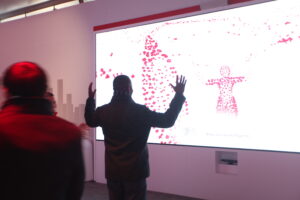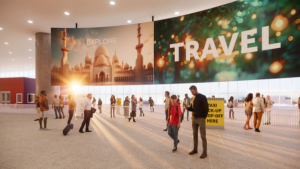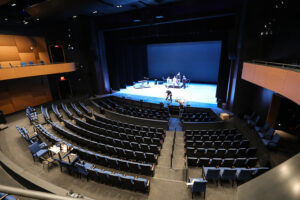
Creating More Effective Meeting Environments for Hybrid Workforces
While it seems that the huge shift to remote work is a phenomenon of the past handful of years, the reality is that many companies were already experimenting with it, and many had fully embraced it. Once called “telecommuting,” the advances in audio and video technology for teleconferencing, coupled with equal advances in software platforms, made it far easier for teams to collaborate remotely. However, a remote workforce sometimes misses out on certain experiences, like serendipitous encounters and meetings over coffee, lunch, or the hallway that often facilitates interactions and relationships that are hard to duplicate in a remote environment. Many companies are now adopting a hybrid approach, where employees work in-office perhaps three days a week and remotely for two. A hybrid approach is popular with employees for the flexibility it affords, but it does present some unique challenges for meetings and collaboration, as remote participants may not feel as present as those in the office conference room.
In this post, we’ll cover how innovative design and modern conference room technology can bridge the gap between remote and office workers, reducing meeting stress and creating a collaborative environment where everyone is seen, heard, and fully engaged.
SEE ALSO: How to Reimagine Conference Room Design for Today’s Digital Workplace
Conference Room Design
The typical conference room has a rectangular table with chairs and an AV system (display, cameras, sound) in the front. With one camera, remote participants might only see small facial representations of those speaking in the room, missing out on facial expressions and even body language.
One approach to making hybrid meetings more inclusive and productive is to design the room with a different table shaped like a U or a half circle. This table shape faces an AV system in the front that can capture faces and bodies in a more frontal position. For remote participants, an extra display or two or a larger video wall with multiple feeds can clearly showcase all the remote participants’ faces, providing a more inclusive approach to the meeting experience.
Visual Engagement
Newer cameras have several features that can increase visual engagement for virtual meeting participants. Cameras with Pan-Tilt-Zoom (PTZ) capabilities can move and focus on an in-room speaker, capturing facial expressions and body movements. These might be more useful in larger spaces. Other options include high-resolution cameras that can accomplish a similar feat through software, automatically finding the speaker and zooming in.
Lighting also merits special attention and design in these new environments. Harsh fluorescent lights can make people look washed out. Lighting now needs to incorporate not only the visibility and comfort needs of in-room participants but also how the meeting space and participants look on camera. In particular, lighting must be adequate to capture the room details but not shine into a camera view to impede the image. Moreover, smart lighting utilizes cool tones to enhance alertness and warm tones to promote relaxation as the workday draws to a close.
Making Sure Everyone Is Heard
One of the biggest issues with remote meetings, whether it’s a purely audio call or a videoconference, is voice intelligibility. In-room participants need to clearly hear remote attendees and vice-versa to avoid the all-too-common refrain, “can you please repeat that?” In the meeting room, that means speaker systems that are loud and clear enough. Depending on the size of the room, some soundbar systems may suffice, but in others, multiple speakers may need to be installed in the walls and ceilings. There are a variety of architectural and even pendant styles that can be integrated into a space. For microphones, beam-forming technology aids in capturing the speaker, but in larger spaces, microphone arrays in the conference table ceiling and individual microphones can be used to increase capture and clarity. Proper DSP (digital signal processing) tuning can ensure the right clarity and tone at multiple volumes, including adjustments for shifting to playing media. In some spaces, acoustic treatment may be necessary to minimize echoes and reverberation as well as keep sound from infiltrating or escaping the room.
Interactivity and Collaboration
Tools like smart whiteboards allow both in-room and remote video conferencing participants to contribute and capture ideas in real time. Combining the physical capabilities of a whiteboard with the convenience of digital recording helps save time re-recording information for later dissemination. Collaboration platforms like Microsoft Teams, Zoom, and Google Meet offer powerful screen-sharing and document-editing features, which allow for flexible engagement and collaboration when integrated with the right displays in the room.
Integration with Collaboration Suites
Integrated suites like Zoom, Google Workspace, and Microsoft Teams also offer ways to integrate the physical conference room with remote conferencing. For example, Microsoft Teams features background noise suppression and real-time transcription to create a more inclusive experience. The novel Together mode furthers the experience, placing local and remote participants in the same virtual background to make everyone feel like they’re in the same space.
Similarly, Zoom Rooms integrates with conference room systems to make meetings easier and stress-free. One-touch join, wireless content sharing, and a Breakout Rooms feature allow participants to collaborate in ways that approximate a physical environment. The innovative Smart Gallery view uses AI to automatically generate individual video feeds of in-room participants, allowing remote attendees to feel more like they’re in the meeting.
For over two decades, McCann has been creating collaborative environments in business, education, and government. For each project, we bring a rich set of skills and experience, as well as a culture of pushing the boundaries of what technology can accomplish for our clients. From building unique inclusive educational experiences at top institutions to state-of-the-art executive boardrooms, McCann is uniquely positioned to help you with the challenges of modern collaboration. If you are looking for a partner to help you improve collaborative experiences for your teams, we’d love to work with you. To learn more, connect with us using the chat button below or fill out our online contact form. We look forward to hearing from you!





